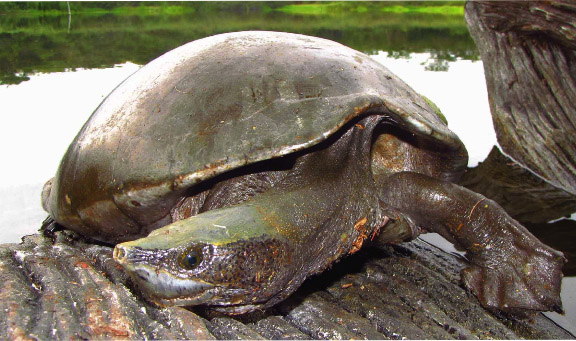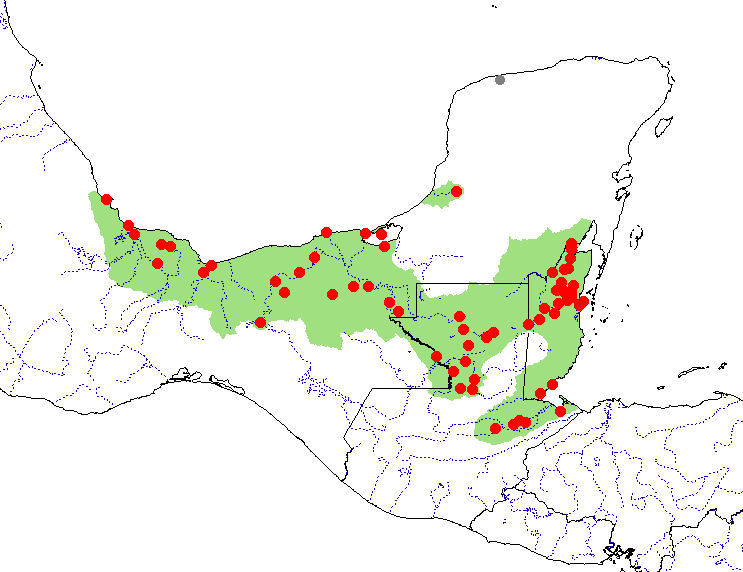Dermatemys mawii, 058
Dermatemys mawii Gray 1847 –
Central American River Turtle, Tortuga Blanca, Hickatee
Richard C. Vogt1, John R. Polisar2, Don Moll3,
and Gracia Gonzalez-Porter4
1Coordinação de Biodiversidade, Instituto Nacional de Pesquisas da Amazônia (INPA),
Av. André Araújo 2936, Aleixo, CEP 69060-001, Manaus, Amazonas, Brazil [[email protected]];
2Wildlife Conservation Society, 4841 1st Street, South, Arlington 22204 Virginia USA [[email protected]];
3Department of Biology, Southwest Missouri State University, Springfield,
Missouri 65804 USA [[email protected]];
4331 Lincoln Ave., Takoma Park, Maryland 20912 USA [[email protected]]
Summary. – The Central American River Turtle, Dermatemys mawii, the single remaining extant species of the formerly wide-spread primitive family Dermatemydidae, is restricted to the Atlantic drainages of southern Mexico, Belize, and Guatemala. This large, highly aquatic, and totally herbivorous freshwater turtle is severely threatened throughout its range. There are older accounts citing specimens over 20 kg and carapace length of 60 cm, but recent field studies have found few individuals in excess of 14 kg in Mexico or above 11 kg in Guatemala. The turtle’s large size and highly palatable meat yield a high profit when the animals are sold at market. This has motivated hunters to overharvest many populations into extirpation. Although Dermatemys is consumed year-round, exploitation peaks during dry weather when low water levels facilitate capture. All forms of capture tend to select for larger size classes, thus not only reducing densities, but altering population structures, resulting in lower proportions of reproductively mature animals. The maturing cohort of smaller juveniles that remains is usually soon removed as well, resulting in unproductive populations in decline. Since Dermatemys is an herbivorous species and grows relatively fast, there is the possibility of raising this species in captivity or semicaptivity in polyculture systems with freshwater shrimp or ornamental fish. Even fast turtle growth rates would probably translate to a relatively slow cash return, suggesting that Dermatemys perhaps be a complementary species in a polyculture system. Where the capital and interest are sufficient, detailed and well-documented experiments testing the overall feasibility of these schemes are advised. However, captive propagation efforts should not distract critical funds and attention from the maintenance of wild stocks in their native habitats. Law enforcement is not the aswer to maintaining wild stocks, and habitat destruction by itself is not the problem—unless local people change their ways and stop eating or selling every Dermatemys they can, there is little chance of rehabilitating wild populations.
Distribution. – Belize, Guatemala, Mexico. Distributed in the Atlantic drainages of southeastern Mexico from central Veracruz through Tabasco, Chiapas, and Campeche, as well as throughout Belize and the Atlantic drainages of Guatemala, reaching the vicinity of the Honduras border.
Synonymy. – Dermatemys mawii Gray 1847, Emys mawii, Dermatemys mavei, Dermatemys mavii, Dermatemys mawi, Dermatemys mawei, Emys berardii Duméril and Bibron in Duméril and Duméril 1851, Ptychemys berardii, Clemmys berardii, Dermatemys berardii, Dermatemys abnormis Cope 1868, Chloremys abnormis, Dermatemys salvinii Gray 1870, Limnochelone micrura Werner 1901.
Subspecies. – None.
Status. – IUCN 2011 Red List: Critically Endangered (CR A2abd+4d) (assessed 2006); CITES: Appendix II.
Citation:
Vogt, R.C., Polisar, J.R., Moll, D., and Gonzalez-Porter, G. 2011. Dermatemys mawii Gray 1847 – Central American River Turtle, Tortuga Blanca, Hickatee. In: Rhodin, A.G.J., Pritchard, P.C.H., van Dijk, P.P., Saumure, R.A., Buhlmann, K.A., Iverson, J.B., and Mittermeier, R.A. (Eds.). Conservation Biology of Freshwater Turtles and Tortoises: A Compilation Project of the IUCN/SSC Tortoise and Freshwater Turtle Specialist Group. Chelonian Research Monographs No. 5, pp. 058.1–058.12, doi:10.3854/crm.5.058.mawii.v1.2011, //iucn-tftsg.org/cbftt/.
(Adobe Acrobat 6.0 or later required)

Adult female Dermatemys mawii from Laguna Peru in the Laguna el Tigre Reserve, Peten, Guatemala.
Photo by Melvin Mérida, Wildlife Conservation Society.
Distribution:

Distribution of Dermatemys mawii in southern Mexico, Belize, and Guatemala. Red dots = museum and literature occurrence records of native populations based on Iverson (1992), plus more recent and authors’ data; gray dot = presumed introduced specimen; green shading = projected distribution based on GIS-defined hydrologic unit compartments (HUCs) constructed around verified localities and then adding HUCs that connect known point localities in the same watershed or physiographic region, and similar habitats and elevations as verified HUCs (Buhlmann et al. 2009), and adjusted based on authors’ data.








